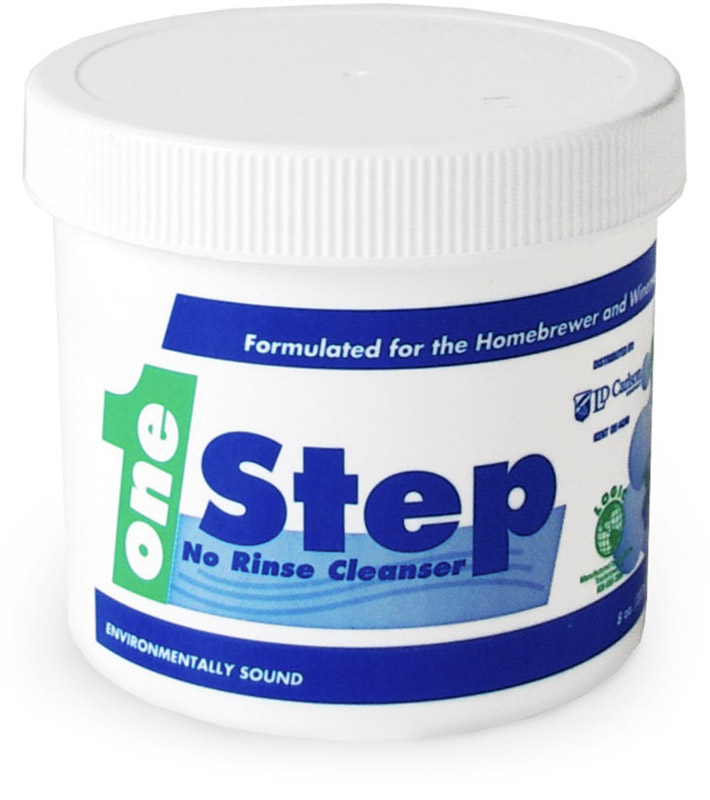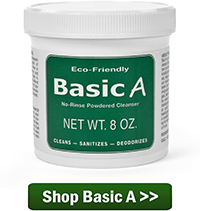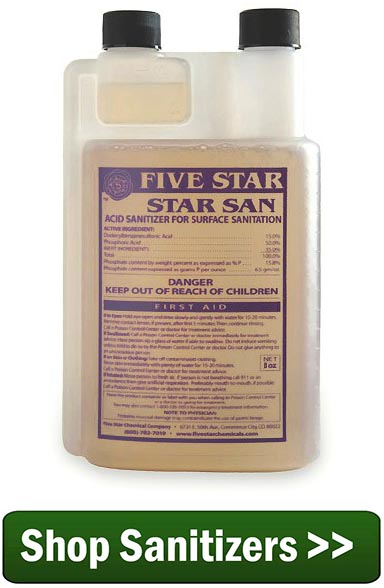 The directions on the container of One Step No Rinse Cleanser simply say to rinse your equipment with the solution. Is there a minimum amount of contact time one must allow for the solution to work prior to using the sanitized equipment? The results of an online search stated anywhere from 30 seconds to 2 minutes. I know the safe route would be to let it sit for at least 2 minutes, but I’d rather not stand there waiting if I don’t have to.
The directions on the container of One Step No Rinse Cleanser simply say to rinse your equipment with the solution. Is there a minimum amount of contact time one must allow for the solution to work prior to using the sanitized equipment? The results of an online search stated anywhere from 30 seconds to 2 minutes. I know the safe route would be to let it sit for at least 2 minutes, but I’d rather not stand there waiting if I don’t have to.
Name: Paul
State: Missouri
—–
Hello Paul,
The One Step No Rinse Cleanser is actually an oxygenating cleanser. This means that it uses a burst of oxygen from the solution to do the sanitizing. This high oxygen level actually destroys any unwanted microbes.
The great thing about any oxygenating cleanser is that it gives the biggest burst of oxygen while the solution is evaporating off the surface of what is being sanitized. In other words, the contact time with the solution is not what really matters. What matters is that the solution be allowed to evaporate without interruption after being taken out of the solution. The amount of time in the One Step solution is not critical. This is way the directions seem so vague.
The only situation when the length of time would matter is if you are treating a piece of equipment that has a lot of tight spots, or has a surface that is complex and  not smooth. A couple examples of this would be a nylon brush or a straining screen. In both cases you would want to give “some” time for the solution to work its way in between and onto the surface of each nylon bristle or into the corner of each square of the screen. This could require a few seconds due to the surface tension of the solution.
not smooth. A couple examples of this would be a nylon brush or a straining screen. In both cases you would want to give “some” time for the solution to work its way in between and onto the surface of each nylon bristle or into the corner of each square of the screen. This could require a few seconds due to the surface tension of the solution.
The flip-side of this is when sanitizing a surface that is smooth, like glass, no time is required in the solution at all. Just dip or apply with a rag and allow to evaporate. Again, the evaporation from the surface is what’s key, not the time in the solution.
If you want to get the most out of the One Step No Rinse Cleanser you would allow your equipment to dry completely before using. However, I understand that following such directions would not be practical in a lot of situations, since it would make things way too time consuming. So as a matter of practicality, I would follow these directions: dip or or wipe with a rag the equipment with the solution of One Step No Rinse Cleanser, then allow to dry for 5 minutes.
One final not I’d like to make is that the One Step No Rinse Cleanser is not a  soap or detergent in any way. It is not designed for or intended to release grime from your wine making equipment. This is something that needs to be done with a dish soap or similar, beforehand. The One Step No Rinse Cleanser is strictly for sanitizing your wine making equipment. It is designed to kill any molds, bacteria, etc.
soap or detergent in any way. It is not designed for or intended to release grime from your wine making equipment. This is something that needs to be done with a dish soap or similar, beforehand. The One Step No Rinse Cleanser is strictly for sanitizing your wine making equipment. It is designed to kill any molds, bacteria, etc.
Happy Winemaking,
Ed Kraus
—–
Ed Kraus is a 3rd generation home brewer/winemaker and has been an owner of E. C. Kraus since 1999. He has been helping individuals make better wine and beer for over 25 years.

Hello I was reading up on the one step cleasner. I have been using Easy clean. Is one better than the other? Thanks
Steve, both are similar products and will sanitize you equipment equally well.
So this product is not really a cleanser but a sanitizer …correct?? Having said that…does it do the same as the metabisulfite solutions?
Bob, the terms "cleanser" and "sanitizer" have been obliterated by the FDA. They have strict rules as to what terminology can be applied to one set of ingredients verses another. From a homebrewer’s standpoint, either will easily rid your equipment of any harmful microbes and there is absolutely no reason to use more than one product just to cover both words. Use either a sanitizer or a cleanser and your beer will be safe. As for comparing them with a sulfite solution, all the cleanser and sanitizers I’ve seen on the market for home brewing are much stronger than a normal strength sulfite solution when used as directed.
Can this cleanser solution be used to rinse out bottles just prior to bottling? I have been using metabisulfate solution but I recently got judges feedback on my wine in which they said the wine had a sulfur smell. Thanks
Nick, the One Step No Rinse Cleanser is perfect for cleaning and sanitizing glass bottles.
Can the same solution be used over and over for say a week?
Mary, the One Step No rinse Cleanser solution will not stay effective for later use. It should be used within minutes or a few hours.
I rinse my carboys with one step before use. Do I need to need to allow them to completely dry before I use them?
Larry, as it says in the article, if you want the best from the One Step then you want to allow it to dry first. However, sometimes that is not practical. If you do not have time to wait for it to dry, dip or or wipe with a rag the equipment with the solution of One Step No Rinse Cleanser, then allow to dry for 5 minutes. However, with a carboy, this may be difficult to do.
would this be good to run thru my filter pump an the transfer tubing, after using it to transfer wine.
Leo, it would be fine to use the One Step No Rinse Cleanser.
I just got an email from the manufacturer in regards to my asking about “pot life” or how long it last after mixing. They say up to four days if kept in a sealed container. I’m tired of iodophor and the potential mess and off flavors. I’m tired of PBW. I wanted one product to do both jobs so I bough five pounds of One-Step.Should be good for a while.
Can this be used to sanitize wine corks? If so should the corks be soak in the solution, or simply wiped down and allowed to dry?
This method should never be used on corks. You should always use sulfites to sanitize corks. Here more:
Preparing Your Corks When Bottling Homemade Wine
https://blog.eckraus.com/preparing-your-corks-when-bottling-homemade-wine
This was helpful. I am using one step for cleaning out SodaStream bottles. I am a big man so 15 of these a week get really irritating to clean. And yes, I use the water mixed with fruit juices(mostly lemon) and bacteria and fungus are an issue. This rocks them clean but thanks for describing the evaporation technique. it is similar to killing envelop bacteria with alcohol. The evaporation of the alcohol is what kills that bacteria, so similar to the oxygen killing here during evaporation. And wanted to know if the storage of ‘mixed’ one step was okay. I will determine that it is not okay and mix only when cleaning. Thank you all for the feedback here. brilliant.
Can this be applied with a spray bottle for larger pots.. seems that would be easier than dipping in large tub
Hye, we recommend following the directions for the one-step no rinse cleanser and they say to dip the item in the solution to properly sanitize. We have no information on just spraying the item with the cleanser to know if it will work properly.
Would this product kill Coronavirus? Lets say we fumigate the work area with this and let it dry in 5 min?
I’m no specialist on viruses, however this product is used routinely to sanitize equipment to make them practically free of bacteria, mold, germs, and yes, viruses in general. Having said this, I am not aware of any test done with this product to monitor the eradication of viruses, specifically.
How long do your bottles stay sanitized after taking them out of the one step solution before filling them
We would recommend using the bottles within a couple of hours after sanitizing.
after sitting in my fermenting bucket for 7 days, the eldeberries leave a sticky film on my bucket that is nearly impossible to get off.what do u suggest for getting this sticky grime off the inside of my bucket? Also after some of my wine sits in gallon bottles for a long time it leaves a film on the inside of the bottle. what can i use to clean this?
John, we have had success removing the Elderberry residue by using Goo Gone or vegetable oil.
Hello all,
I don’t want to mix a full gallon every time I need to sanitize something. Currently that’s what I’m doing, then pouring into a spray bottle that holds 24z. i tried to find a dilution chart or something of that nature for different levels of mixing for different amount of liquid but have come up empty. Does anyone know if there’s anything official on this, or is it best practice to just make a gallon and dump what i don’t use? I know it’s only a tablespoon, but i really don’t like being that wasteful.
Thanks!
1 tablespoon equals 3 teaspoons and 1 gallon equals 16 cups. So, you could do 1/2 tablespoon to 1/2 gallon (8 cups). Or, you could do 1 teaspoon to 5.33 cups. Just do the math.